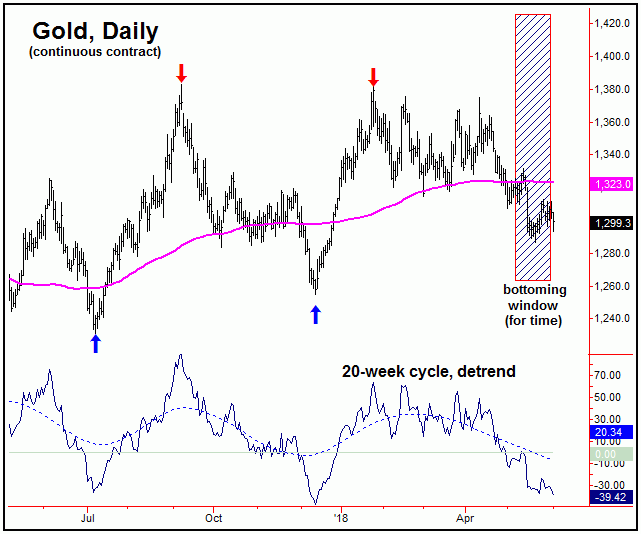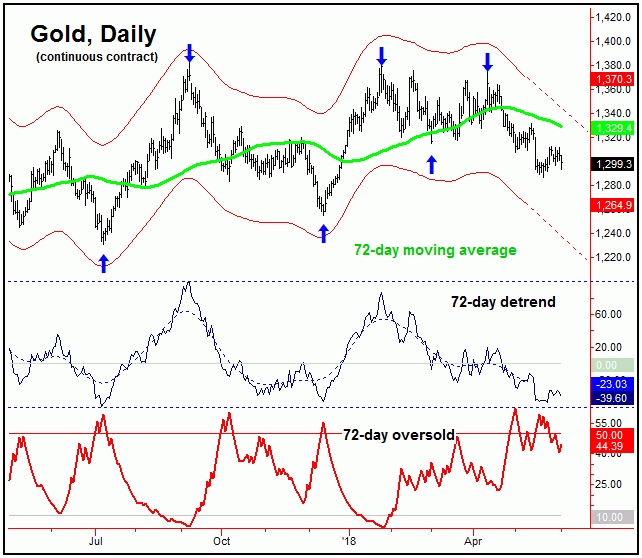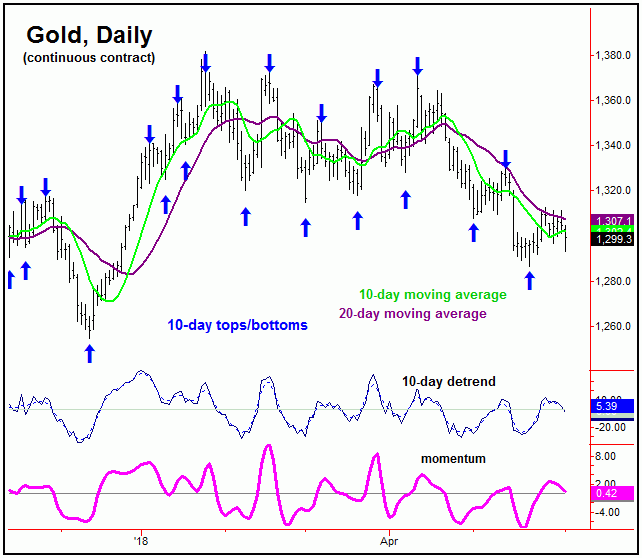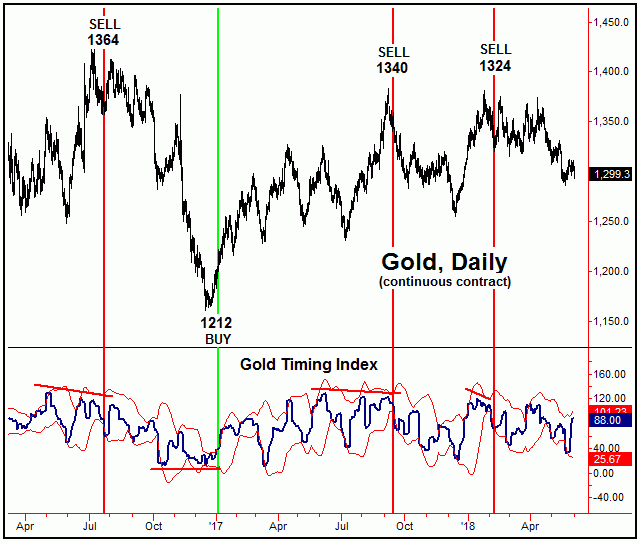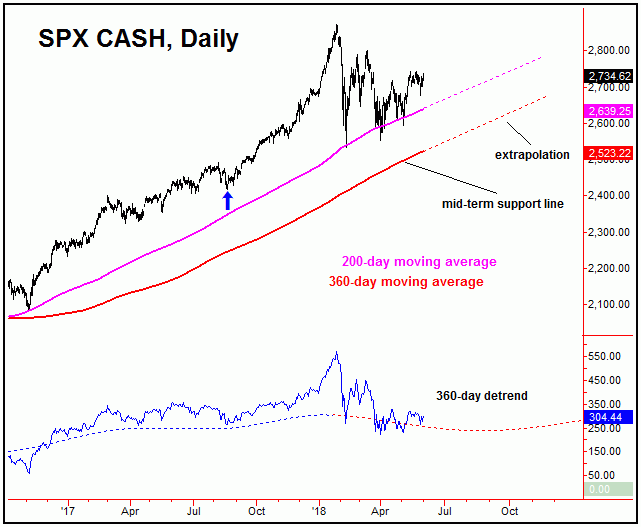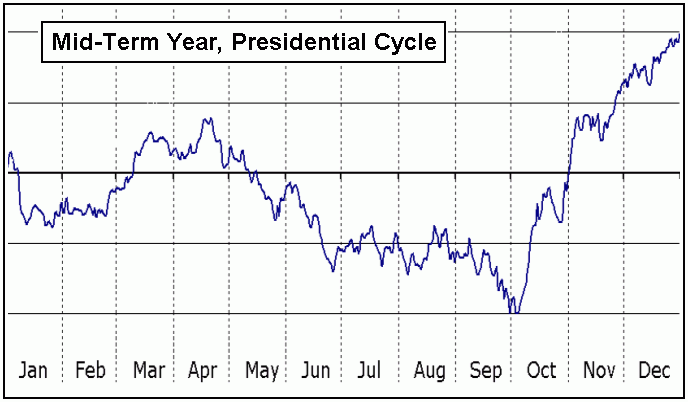Gold Cycle And Stock Market Outlook

Due to numerous inquires regarding the U.S. stock market, in this week's article I have decided to take a look at the cycles in the SPX, though first we want to take another look at Gold - which was fairly quiet last week.
Gold's Mid-Term Picture
From the comments made in recent articles, the next low of significance for the Gold market has been expected to come from the combination of 72-day and 20-week cycles, with the latter being the most dominant mid-term cycle in the Gold market at the present time. Here again is our 20-week cycle:
In terms of time, this 20-week cycle is in bottoming territory, though there is no indication that this low is yet in place - thus keeping the door open to lower numbers (below 1286, August 2018 contract) before this bottom is actually set in place.
The next chart shows the 72-day wave for Gold, which is currently 65 trading days along - and thus is also in normal bottoming territory:
Having said the above, we noted that - in order to actually confirm a low in place with the 72-day and 20-week waves, Gold (August contract) would need to see a reversal back above the 1332.00 figure. This number could start to drop going forward, and the most up-to-date numbers are published in my thrice-weekly letter.
Short-Term Outlook
For the very short-term, the upward phase of the 10-day cycle was recently in force, which took the metal up to a recent high of 1312.60. From there, however, its downward phase was deemed to be back in progress - where it remains heading into the new week. Here again is that 10-day wave:
With the above said and noted, as long as the 1332.00 figure is able to contain any short-term strength, a push back below the 1286.50 swing bottom can easily still materialize. If that lower low were to be seen on the current downward phase of the 10-day cycle, then our upside ‘reversal point’ for the larger 34-day, 72-day and 20-week cycles should also start to drop - though this depends on the accompanying action with technicals.
Stepping back, if and when the 72-day and 20-week cycles do bottom out, a rally of 39 trading days (approximately two months) is expected to play out, and should be at least 8% off the bottom - though with the statistical average being closer to 16%. In terms of time, our current assumption is that the next upward phase of these waves will play out into mid-to-late Summer, thus setting the metal up for another peak - and another decline phase into the Autumn of the year.
Gold Timing Index Update
From the comments made in recent articles, our Gold Timing Index is our best indication for mid-term buy/sell signals for the gold market - though these signals won't always appear following a peak or trough. However, when they do show up, they are very strong signals that a mid-term turn has just taken place. Here again is our indicator, in chart format:
For our Gold Timing Index to set up for a mid-term buy signal, the indicator first needs to register a divergence - which it recently did, though that divergence ended up being negated with the action that followed. With that, we are watching to see whether this divergence develops again in the coming days, which it could well do - though it would require the metal itself to make a push back below the 1286.50 swing bottom.
The second requirement for a mid-term buy signal in our Gold Timing Index is for a close above its upper standard-deviation band, which obviously can't occur until requirement #1 is met. With that, we will be keeping a close eye on this in the days ahead, should lower lows be seen.
The Bottom Line For Gold
The overall bottom line for the gold market is that the metal is still in the process of forming the next mid-term trough, which is expected to come from the combination of 72-day and 20-week time cycles. From whatever low that ends up being seen with these waves, a sharp rally is favored to play out into mid-to-late Summer, before setting up for another peak - and another mid-term decline phase - into the Autumn of the year.
Mid-Term Outlook For The S&P500
As mentioned earlier, this weekend I wanted to take a side look at the S&P 500 index (SPX). The last decent low for stocks was registered back in February of this year at the 2532.69 SPX CASH figure, which was our last trough for the 180-day (9-month) time cycle. The next bottom for this wave is projected for the Autumn of this year, and which should also trough the larger 360-day wave, which is shown on the chart below:
The last combination bottom for the 180 and 360-day cycles was registered back in August of 2017, doing so at the 2417.35 SPX CASH figure. In terms of patterns, the downward phase of the current 360-day wave is expected to remain above that same figure - thus forming the pattern of a 'higher-low'.
Having said the above, a normal decline with the 360-day wave will usually see a drop back to the 360-day moving average on the SPX, and thus we are looking for an eventual tag of this average in the coming months, with a particular focus on the late-September timeframe to bottom these 180 and 360-day waves. Take a look at our next chart:
Mid-Term Year Within The ‘Presidential Cycle’ Pattern
The chart above shows what the average mid-term year looks like inside the ‘presidential cycle’ pattern in stocks. This same year has a decent history of recording major price bottoms, which you can see are normally made around the late-September to early-October timeframe. Note that this is right in line with what the 180 and 360-day time cycles are suggesting will materialize.
With the above said and noted, the ideal path for the mid-term is for a Summer rally that fails, eventually giving way to a semi-important bottom for stocks into early-Autumn of this year - with that low ideally made from somewhere at or below the 360-day moving average, but above the 2417.35 SPX CASH figure (the prior 180 and 360-day trough).
For the bigger picture, in looking at a low-end statistical analysis of the 360-day time cycle, the following rally phases of this wave have normally seen minimum rallies of 20% or more before peaking, thus giving us some early idea of how the SPX will play out, following an Autumn, 2017 bottom. Obviously, this is something that we will need to take a closer look at, at the time, as the price and technical action develops in real-time. Stay tuned.
Jim Curry
The Gold Wave Trader
http://cyclewave.homestead.com/
Jim Curry is the editor and publisher of The Gold Wave Trader and Market Turns advisories - each of which specializes in the use of cyclic and statistical analysis to time the Gold and U.S. stock markets. He is also the author of several trading-related e-books, and can be reached at the URL above.
********

